Junkers gas boiler malfunctions: breakdown codes and troubleshooting
A boiler breakdown at the height of the heating season is a terrible dream for each owner of this equipment, isn’t it? It so happened that the boiler got up, it is cold in the house, and the master can come only in a few days? Such malfunctions of the Junkers gas boiler can cause despair.
Do not rush to panic, because many breakdowns of gas boilers can be eliminated independently without experience and a special tool, and we will teach you this.
In this article, we will not only give decryption to the error codes that the boiler gives, but also associate them with the current state of the unit. We will also tell you how to fix some malfunctions and in which cases you can not do without the help of a specialist.
The content of the article:
The gas boiler does not turn on
When the boiler does not work and no light is on, it doesn’t react to the power button, the owner is overcome by the most terrible suspicions: the unit is hopelessly broken, a serious repair or installation of new equipment will be needed.
The self-diagnosis function of the boiler is powerless and the device will not issue an error code.
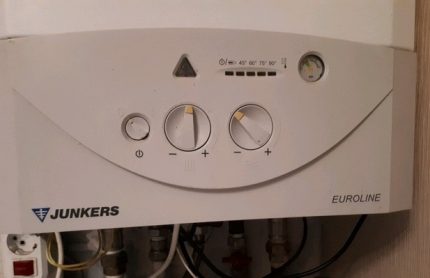
Often the reason is elementary: the plug is pulled out of the socket, or the machine is turned off. The plug could be pulled out by the child while playing, and the machine could be disconnected to protect against a network failure. In addition, there may be no power supply throughout the house - during the day this can easily be overlooked.
If everything is normal with power and the boiler is still silent, unplug it and remove the front cover. The control panel in wall-mounted models is usually fastened with two bolts, and the cover of the main compartment is screwed in at the corners - a screwdriver is enough to remove them.
The problem may be a blown fuse on the control board, while the series boilers Eurostar may issue error E9. Find it and inspect, if possible, check with an ammeter. If fuse replacement is required, look for a replacement one on the inside of the cover or other elements of the boiler body. As a rule, Junkers makes such a margin for the user.
After checking the markings, replace the fuse and try to start the boiler without directly assembling it. If everything worked, you can breathe a sigh of relief, if there is no reaction or the new fuse immediately burns out, you need to call a specialist.
Inspect the inside of the apparatus for signs of short circuits, leaks, broken or torn wires.
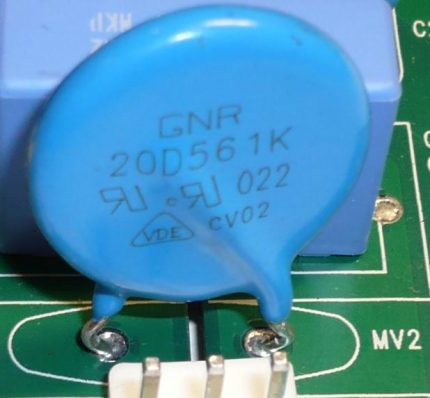
A varistor may be blown or damaged on the board - this indicates that there has been a power surge. Repair is not too complicated and expensive, but it requires soldering the board, and we strongly recommend not doing this on your own. Entrust the work to the master, and purchase a voltage stabilizer yourself.
It happens that the boiler does not start to work, even when the house is cold. In this case, standby mode may be displayed on the display or indicators, and on EuroStar models - SS error. This indicates a lack of communication with the room temperature sensor or the boiler thermostat. Check the integrity of the wires and connections, tighten the contacts. If everything is intact, turn the knob on the mechanical sensor, and replace the battery on the electronic one.
If a boiler with piezo ignition tries to ignite a burner, gives a spark, but does not ignite - most likely there is no gas supply or it is defective gas valve.
After several unsuccessful attempts to start the ruler model Ceraclass and Eurostar flash EA error “The flame is not detected”, the reset button and the temperature indicator 60 flash on the Euroline.

In such a situation, you can only try to light the stove or unscrew the gas hose of the boiler (with the tap turned off and the boiler turned off) and try to open the gas briefly. If there is a hissing sound or the stove turns on - the problem is in the boiler, you need to call the specialists from the service department with whom maintenance contract gas equipment.
If there is no hiss, then the gas supply to the house is turned off, wait until the gas supply is restored. In any case, the unscrewed gas hose must be connected back to the boiler without losing the gasket.
The boiler is constantly shutting down
One of the most common problems: the boiler starts to work, the burner ignites, and then turns off. It may issue error E9, CE, EA or a lamp of 45 or 75 degrees blinks - “there is no ionization current”.
Such a problem can occur each time when firing up or occasionally, unpredictably, instantly or after a short period of time - because the reasons for this behavior of the boiler can be different. We will discuss further possible problems and their solutions.
Reason # 1 - filter clogged
This is a common malfunction. double-circuit boilers, which is rarely indicated by self-diagnosis, because the water supply filter is usually located outside and is not connected to the sensor.
The shutdown occurs when you try to switch to DHW, because the water does not enter the coil or goes with a weak pressure and the boiler overheats.
To clean the filter, turn off the boiler and locate a section in the shape of an inverted letter “U” on the water supply pipe to the boiler.
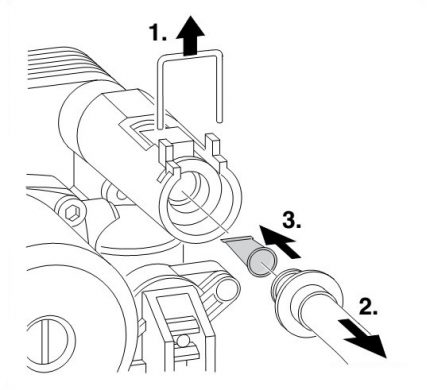
Before and after it, turn off the taps, unscrew the nut - tip. Remove and rinse the net thoroughly, rinse the housing. If the cartridge is damaged - bent or burst, then buy a new one. Put everything back and open both taps.
Reason # 2 - the pump is jammed
In most models of gas boilers, the Junkers pump is built-in and is controlled by the system, a 45 degree diode blink indicates its malfunctions, error E9, depending on the model.
To find out if the pump rotor is jammed, it must be disassembled.
To do this, follow these steps:
- turn off the boiler;
- find the pump in the lower right part of the boiler;
- put a small container under it;
- to remove the cover, unscrew the screw with a large shiny head under a flat screwdriver;
- a little water will pour from the pump - make sure that it does not get on the printed circuit board and other electronics;
- try turning the rotor slightly in the depth of the pump with the tip of a screwdriver. If it goes easily, we collect and look for a malfunction further; if not, we repair or replace the pump;
- reassemble everything in reverse order.
A more risky, but also more accurate way of checking is to turn on the boiler with a disassembled pump and blocked water and gently push the screwdriver deep into the characteristic sound from touching the rotating rotor.
If the pump is clogged with air entering the heating system, a special valve will help to lower it.
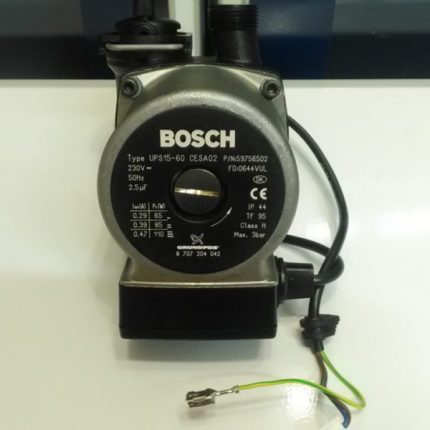
Depending on the design, it can be unscrewed or raised. With the coolant supply valve open, the air will sizzle and the boiler will start working as before.
Reason # 3 - sensor defective
It happens that the main burner manages to light up, but immediately goes out and the boiler gives out EA error or the 60 degree diode flashes. This means that it does not work correctly. flame detector - a thermocouple or an ionizer diode, and the protection that shuts off the burner in order to prevent gas leakage without burning is erroneously triggered.
To fix such a malfunction, it is not always necessary to change the sensor, sometimes it is enough to pull the boiler plug out of the socket and insert it upside down. Such manipulation helps because many Junkers boilers are phase-dependent, if the phase and zero at the boiler and in the socket do not match, the ionization current does not form and the sensor does not work.
Another reason for such a breakdown is a zero and ground fault in any part of the wiring in the house. Remember, have you recently driven in nails or connected a new electrician? All equipment with this circuit works, only grounding is incorrect.
If a similar problem is found, fix it and restart the boiler.
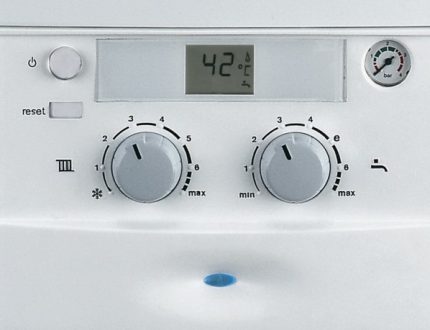
In all the cases described above, the boiler turned off immediately, could not enter the operating mode even briefly.
If the device as a whole works, but sometimes, at different intervals of time, more often from several hours and days, the error “arises” is not set by mistake EA, then the fault is most likely due to the low-quality and unstable voltage in the network.
This situation is not only annoying, but also threatens board breakdowns. To prevent this, purchase a voltage regulator.
Low coolant pressure
On the front panel of each boiler there is a pressure gauge indicating heating pressure. It has red zones of too low and too high readings. A pressure of 1.5 bar is considered normal for a cold boiler: at 1 bar, the arrow is already in the red zone, and at 0.5 bar the boiler will shut off by CE error or CF until pressure is restored.
If the boiler was installed recently - a few weeks ago, this situation is normal, you just need to add clean water through a special tap. But do not rush to add water to the system, which has been in operation for several years.
When heated, the water expands and the pressure rises - this is the norm. However, if it jumps immediately to 0.7 - 1.5 bar, this indicates a lack of air in the expansion tank.
If in this situation, add water, heating up, it will increase the pressure too much and the safety valve will work, discharging the excess coolant.
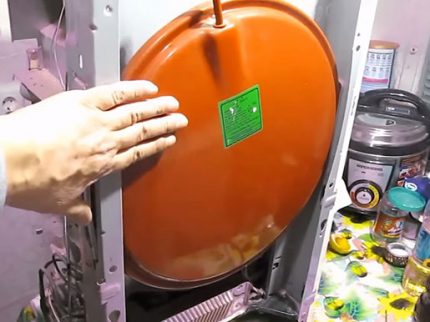
To pump the tank, first you need to relieve pressure on the boiler off, draining a little water. Then connect the pump or compressor to the fitting in the upper distal part of the tank and pump it up to 1.3 - 1.4 bar. Having switched off the pump, add water, bringing the pressure in the cold system to 1.5 - 1.6.
If even when the boiler is heating up, the low pressure in the heating circuit is maintained, then it is really necessary to add water. Where to find the tube intended for this is indicated in the instructions for the device model, we only recall the need to fill this tube with water before opening the tap so that air does not enter the pump and batteries.
Be sure to check all the faucets, connections and radiators, as well as the inside of the boiler for leaks - the water circulating in the system went somewhere.
No draft in the chimney
Problems with draft are also familiar to all types of boilers - both with an ordinary chimney and with a coaxial one. Point to this problem A4, C4, C6 errors, blinking of the diode 45 degrees, sometimes alternately from 90 degrees.
If such errors occur, first of all, you need to find out if there really is a problem, because traction sensor could have worked erroneously, and failures C4 and C6 may also indicate problems with the pressure switch.
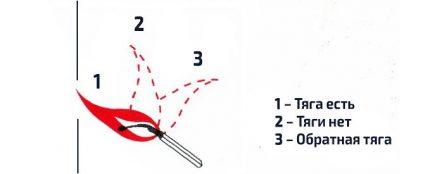
To check the draft, first find out where your boiler takes combustion air from. Models with an open combustion chamber take it from the room, usually through a grate in the bottom of the wall and on the side of the floor versions. With the combustion chamber closed, air is taken from the street through the outer pipe of the coaxial chimney.
Hold a piece of paper near the air intake point while the equipment is operating or trying to work. If it sticks to the grate or is pulled into the pipe, then everything is fine with traction.
If there is draft, but weak, it may not be enough to hold the paper. In this case, a burning match is used for verification.
Open chamber boiler
Most often, when traction errors occur, it really is not. The main reason is problems with the chimney. He can be:
- clogged with soot or acid condensate;
- clogged with foreign bodies - sometimes birds can make a nest in the chimney, the remains of which will fall into the inside;
- incorrectly calculated - too thin or short;
- insufficiently insulated, an air congestion formed.
Inspect and clean the pipe, if necessary, use the services of specialists.
Turbocharged gas boiler
For air exchange in boilers with a closed combustion chamber, a fan is controlled by a flue gas pressure switch - a pressure switch.

The cause of traction disturbance is usually a malfunction of one of these devices.
The owner of the boiler himself can check the integrity of the inductor with a multimeter - it must have a resistance of 50 - 80 Ohms, otherwise it must be replaced. Also, due to accumulation of dirt and dust, the fan impeller may be unbalanced.
To detect this, remove the turbine, blow it away from dust, and rotate the impeller several times. If it always stops in one position, attach a weight to the upper blade and check again.
In addition, the pressure switch may not start the fan due to a low voltage in the network: check it with a voltmeter in the socket, the lower threshold of acceptable voltage is 195 V. If this is the problem, connect the stabilizer.
To check the operation of the pressure switch, connect the fan directly and try to start the boiler. If problems in operation disappear, the pressure switch needs to be replaced.
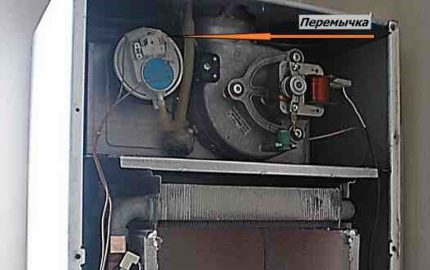
Boilers with a closed chamber are supplied coaxial chimneyswhich are installed horizontally, and therefore practically not prone to clogging. However, during severe frost, icing of the pipe end may occur due to condensation freezing or improper installation of the equipment.
You can get rid of this problem by carrying out the insulation of the chimney.
Other faults and code values
Most error codes that we have not yet mentioned indicate a distress signal from a specific sensor, caused by its breakdown, line breakage or malfunction of controlled equipment.
You can find out all the error options that the Junkers wall-mounted gas boiler produces and repair it, in the instructions for your model. Depending on the series, method of indication and configuration of the boiler, the list of errors may differ, and sometimes the same code in different models does not have the same meaning. Therefore, we will not give a complete list here, so as not to confuse you.
Malfunction # 1 - noise during operation
The boiler body is not tight and dust often settles in it. Most of all, it accumulates on the fan impeller, because it sucks dirty air from the boiler.
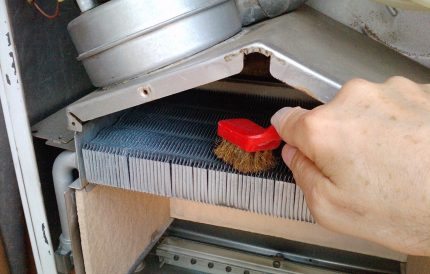
If you have an air compressor, the problem is easy to fix. Remove the front panel of the boiler and unscrew the turbine. Blow the entire fan, then the place of its landing, and then the entire boiler, with compressed air. Be careful when cleaning the circuit board - an air stream can knock down contacts.
Allow the dust in the room to settle and re-purge the boiler. Do a few of these cycles until completely cleaned.
The impeller and fan housing can be wiped with soapy water - just do not wet the motor and electrical contacts. If there was a lot of dust, ask a specialist from the Junkers gas boiler maintenance and repair company to remove and wash the gas burner as well. You shouldn’t do this yourself - an incorrect installation threatens with a gas leak and explosion.
Malfunction # 2 - the batteries do not heat up
If the double-circuit boiler does not switch to heating mode, even when all hot water taps in the kitchen and in the bathroom are closed, the flow sensor is most likely defective or three-way valve. The error in this case, as a rule, is not displayed - it seems to the boiler that there is a constant water intake, and it works in accordance with this situation.
If you have been using hot water for a really long time and the batteries have cooled down, the boiler is operating normally, and the DHW circuit is in priority.
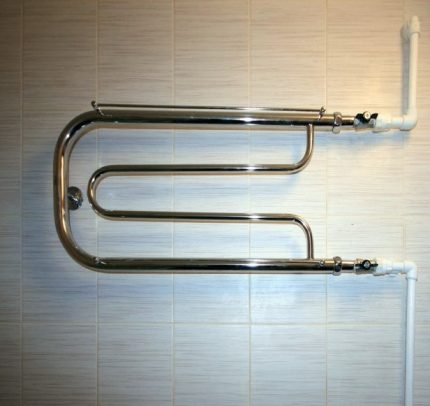
When such a problem arose already at the first start after installation, design errors are possible. For example, a heated towel rail can be connected to the DHW circuit, as in high-rise buildings with a centralized supply of hot water.
In it, water constantly circulates, and therefore the flow sensor does not close and does not allow the boiler to start heating.
Malfunction # 3 - board errors
The electronic control board is the most capricious and expensive part of a modern boiler, its error F0, E0 or a flashing indicator of 75 degrees can seriously upset the owner who has looked into the instructions for the decryption.
However, things are not always so bad: maybe the contacts just left, and on the boilers of the Cerapur series it also indicates the wrong ratio of gas and air supplied to the burner. The cause of the malfunction can also be moisture on the circuit board.Everything will work after thorough drying.
It has been experimentally established that sometimes board errors resolve themselves if you set the 5th fan operation mode.
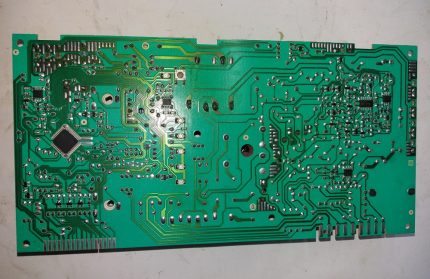
In addition, sometimes the board does not work correctly, the boiler behaves strangely, but does not give an error. The reason for this may be the low quality of electricity. Try disconnecting the boiler from the mains for half an hour so that all capacitors are discharged, and then start again. If it helped - that’s the problem. Resetting to the original settings may also help.
The specialist can also solder or reflash the board, restoring its performance.
Conclusions and useful video on the topic
You can more clearly get acquainted with the most common breakdowns of Junkers boilers and their independent repair on video.
Flow sensor troubleshooting:
DIY boiler repair Junkers:
As a conclusion, we can note that not every error generated by the boiler’s self-control is fatal. Do not be afraid of self-repair of the Junkers boiler: many malfunctions can be eliminated without the help of a specialist. But we do not recommend to intervene in the gas pipeline and solder the board yourself, this is too risky.
Did your Junkers boiler stop by mistake? Did you manage to solve the problem yourself or did you have to resort to the help of specialists? Tell our readers about this - join the discussion in the comments.

 Kiturami gas boiler errors: trouble codes and troubleshooting
Kiturami gas boiler errors: trouble codes and troubleshooting 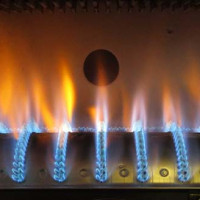 Conord gas boiler malfunctions: common breakdowns and solutions
Conord gas boiler malfunctions: common breakdowns and solutions 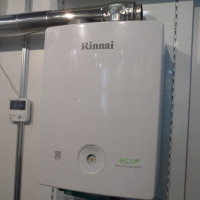 Rinnai gas boiler errors: trouble codes and ways to fix them yourself
Rinnai gas boiler errors: trouble codes and ways to fix them yourself 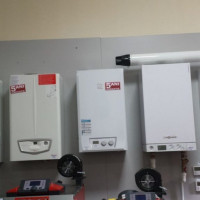 Immergas gas boiler errors: error codes and solutions
Immergas gas boiler errors: error codes and solutions 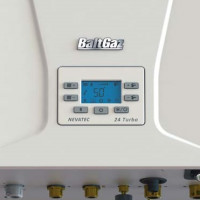 Errors of gas boilers Baltgaz: trouble codes and troubleshooting methods
Errors of gas boilers Baltgaz: trouble codes and troubleshooting methods 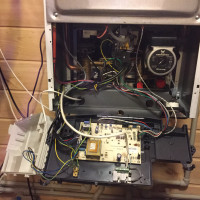 Baxi boiler error codes: what are the codes on the display talking about and how to eliminate typical malfunctions
Baxi boiler error codes: what are the codes on the display talking about and how to eliminate typical malfunctions  How much does it cost to connect gas to a private house: the price of organizing gas supply
How much does it cost to connect gas to a private house: the price of organizing gas supply  The best washing machines with dryer: model rating and customer tips
The best washing machines with dryer: model rating and customer tips  What is the color temperature of light and the nuances of choosing the temperature of the lamps to suit your needs
What is the color temperature of light and the nuances of choosing the temperature of the lamps to suit your needs  Replacement of a geyser in an apartment: replacement paperwork + basic norms and requirements
Replacement of a geyser in an apartment: replacement paperwork + basic norms and requirements